How To Do A Dumbbell Shoulder Press
Build boulder shoulders with this powerful move
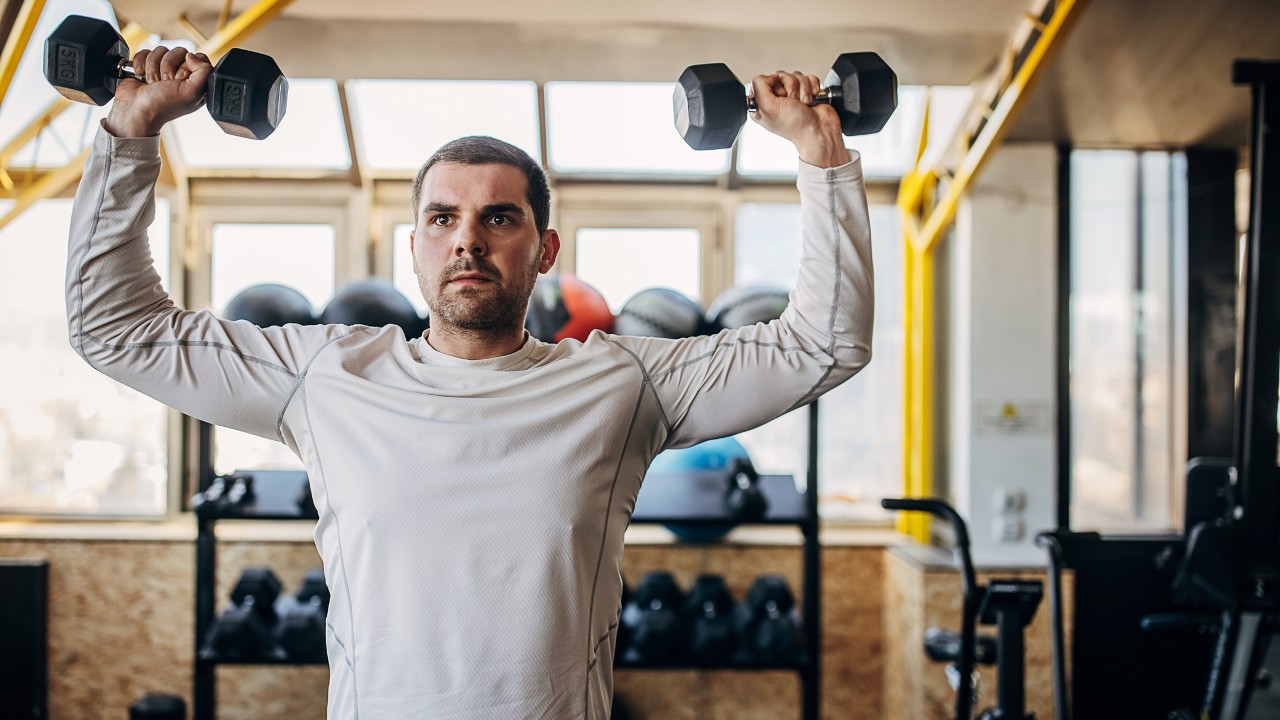
In these days of budget airlines hand luggage is king. Every regular traveller has a suitcase that pushes the limits of the size allowance for on-board bags without ever exceeding them, because nothing ruins the start of a holiday like having to pay a premium to check your luggage into the hold.
Why are we talking about this? Because this is just one example of how lifting heavy objects overhead is now a key life skill and no exercise prepares you better for this than the shoulder press (also known as the overhead press), which is arguably the best shoulder exercise going. What’s more, compared with the barbell, dumbbell exercises allow you to work each side of your body independently, preventing or remedying any muscle imbalances.
So if you want strong, broad shoulders that make you the envy of everyone in the cabin, add the dumbbell shoulder press to your gym routine. Check out the form guide below, and remember to come back and thank/shout at us when everyone on your next flight asks you to lift their baggage into the lockers.
Dumbbell Shoulder Press Benefits
For many, the dumbbell shoulder press is the exercise for building shoulder strength and size. As a compound movement that recruits the triceps and chest as well as the shoulder muscles, it allows you to move more weight than other shoulder-focused exercises such as the lateral raise or Arnold press. Engaging these muscle groups can help them grow as long as you are following the principles of hypertrophy training.
The dumbbell shoulder press also has an edge over its barbell equivalent, aside from helping to prevent muscle imbalances. Research published in The Journal Of Strength And Conditioning Research found the standing dumbbell shoulder press stimulated more muscle activity in the front and middle parts of the shoulder than its barbell counterpart.
The study compared electromyogram activity (EMG) in the anterior, medial and posterior deltoids in 15 healthy men during barbell and dumbbell shoulder presses performed both seated and standing. It found EMG in the anterior (front) deltoids was, on average, 15% lower during a standing barbell overhead press than a standing dumbbell shoulder press. It was also 7% lower in the medial deltoid.
How To Do The Dumbbell Shoulder Press
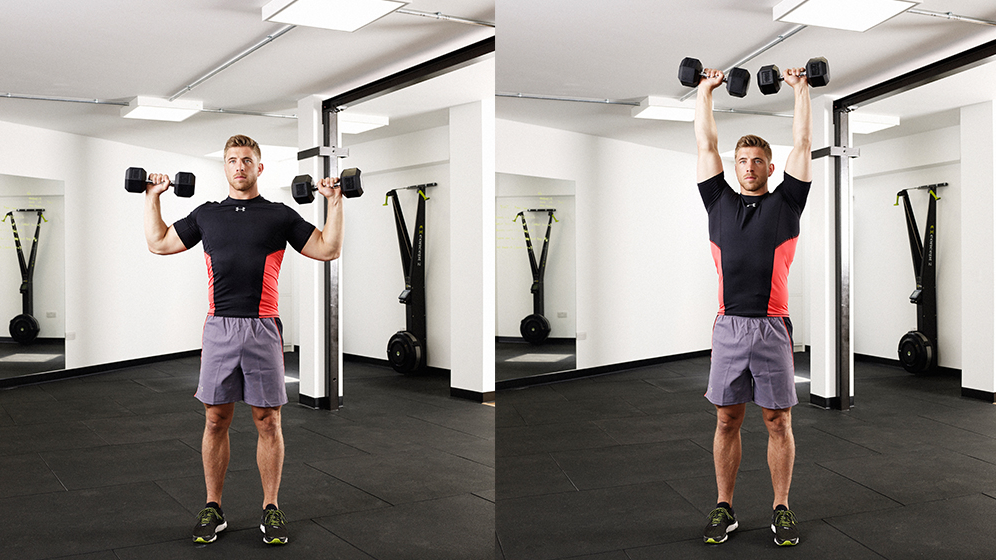
First, select your dumbbells. Don’t go overboard on the weight here, because this is an exercise that suddenly feels very tough halfway through a set. You almost want to feel like you’ve picked too light a weight for the first couple of reps. Opting for too heavy a weight can also mean you risk injury to your shoulders if your form gets sloppy as a result of the load.
Get the Coach Newsletter
Sign up for workout ideas, training advice, reviews of the latest gear and more.
Hold the dumbbells by your shoulders with your palms facing forwards and your elbows out to the sides and bent at a 90° angle. Without leaning back, extend through your elbows to press the weights above your head. Then slowly return to the starting position.
Form Tips
If you’re lifting heavier weights, manoeuvring the dumbbells into the starting position can be tricky. Rest the ends of the dumbbells on your knees, then explosively lift your thighs to kick them into position without putting undue stress on your shoulders and rotator cuffs.
Another top tip if you’re looking to build muscle is to stop just short of fully locking out your elbows when pressing the weights overhead. This will maintain tension in your shoulder muscles throughout the movement, maximising their time under tension during each rep.
Dumbbell Shoulder Press Variations
Seated dumbbell shoulder press
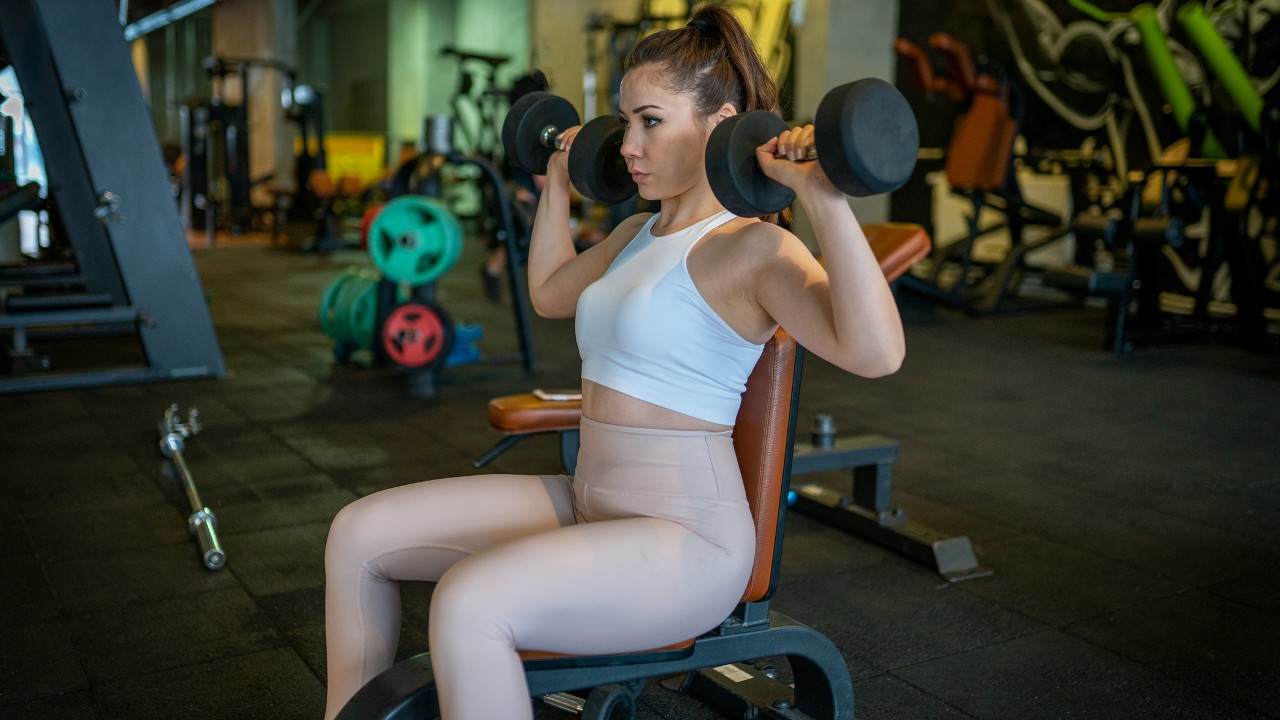
Shoulder pressing dumbbells from a seated position – using a bench with an upright back for complete support – allows you to lift heavier than the standing version, something the study mentioned above confirmed. Why’s that? You no longer have to support your torso (the bench takes care of that) so you have a more stable base from which to generate pushing power. As a result you get to grow bigger and broader shoulders. Here’s how to do it.
Sit on an upright bench holding a dumbbell in each hand at shoulder height with your palms facing away from you. Keep your chest up, brace your core and look straight forwards throughout the move. Press the weights directly upwards until your arms are almost straight and the dumbbells are directly above your shoulders. Slowly lower the weights back to the starting position, pause, then start the next rep. If you bounce back up from the bottom position, you’re placing greater strain on your shoulders and using momentum to move the weights instead of your muscles.
Always remember to warm up thoroughly when attempting any heavy lifts with your shoulders because the shoulder joint is one of the most intricate and mobile in the human body, making it more susceptible to injury.
Dumbbell push press
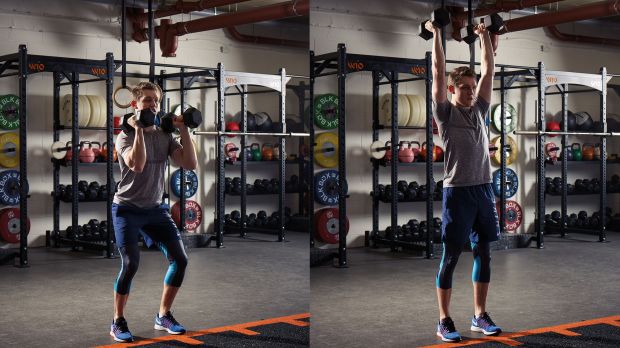
For a more dynamic shoulder move, try the push press. This exercise has the added benefit of allowing you to lift heavier weights than a standard shoulder press, although you should only increase the load when you’ve perfected your form.
Stand holding dumbbells next to your shoulders with your elbows pointing to the sides. Bend your knees to lower into a quarter squat, then push up through your heels and press the weights above your head, using the momentum generated by your legs to complete the movement. Slowly lower the dumbbells back to your shoulders.
Hammer shoulder press
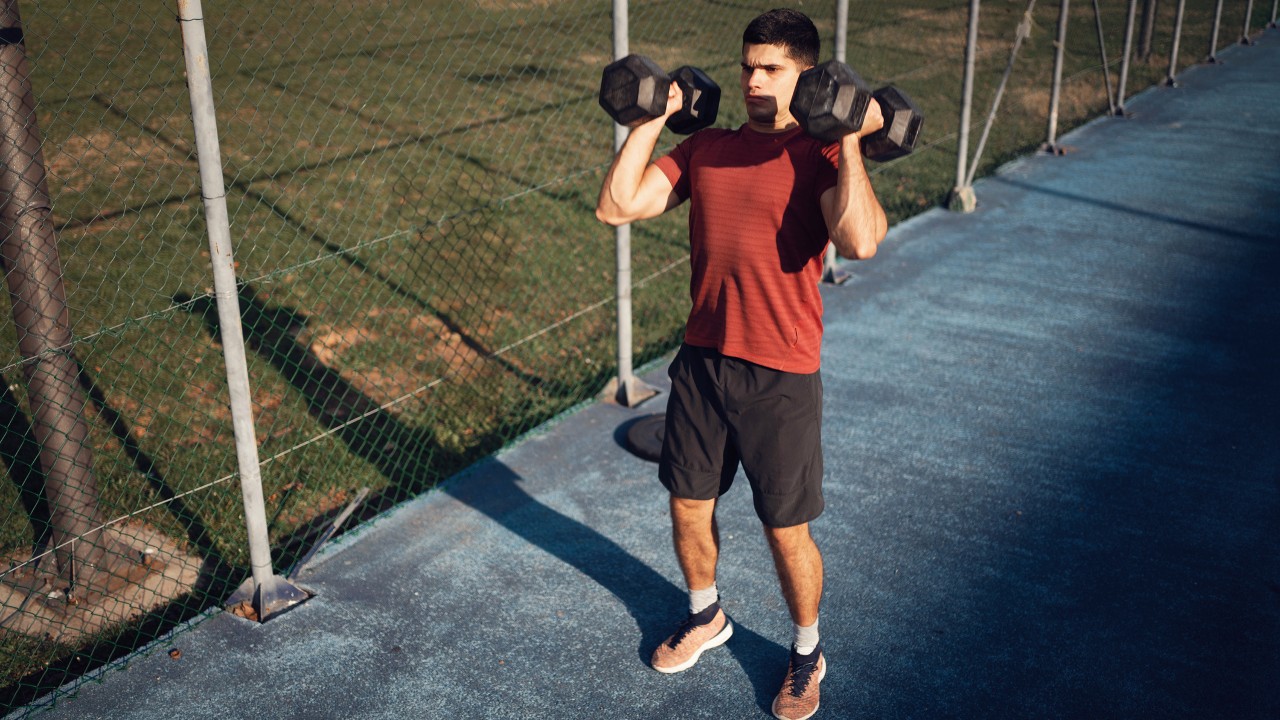
For this variation, change your grip so that your palms are facing each other while lifting the dumbbells. This change in grip recruits different muscles in the shoulders and can also put less pressure through the joint than the traditional method, so if you’re looking to reduce the stress on your shoulders while still strengthening them, the hammer variation is one to consider.
Dumbbell thruster
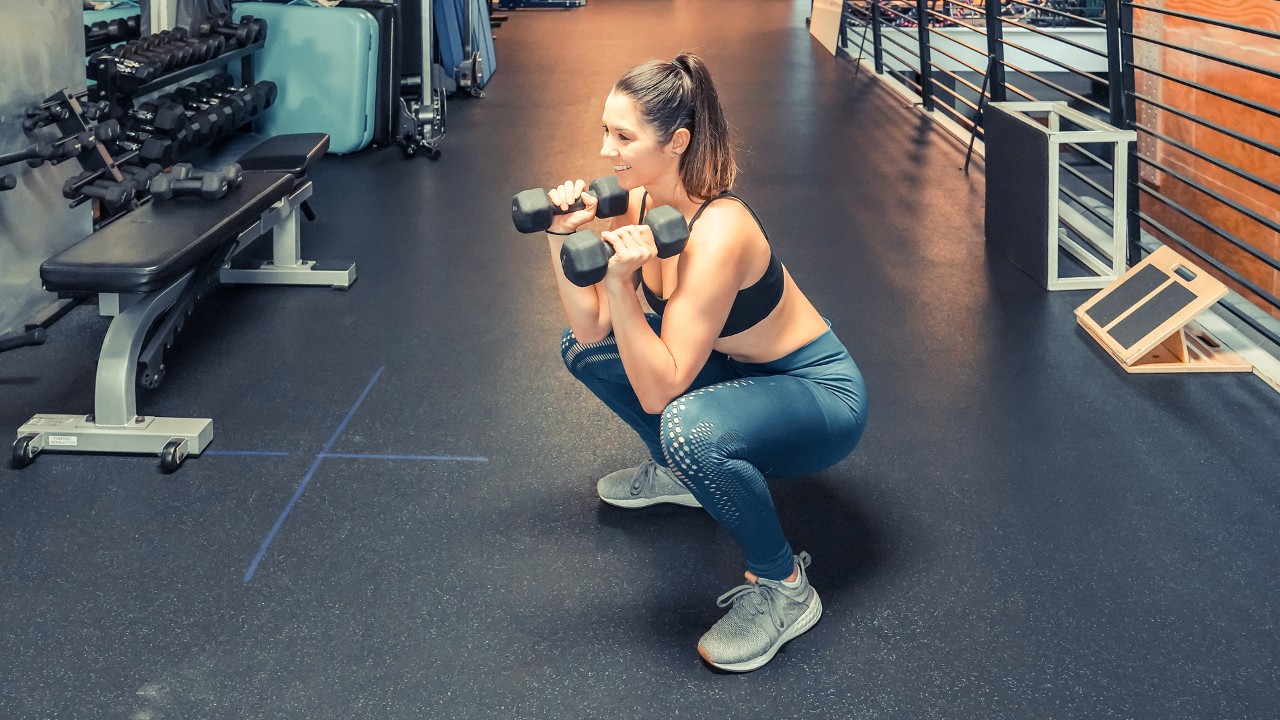
While in the push press you drop into a quarter squat before pressing the weights overhead, the thruster incorporates a full front-racked dumbbell squat to create an incredibly demanding total-body movement. It’s a terrific compound exercise that works muscles all over the body – hard. Popular in CrossFit and HIIT workouts, it can also be a great conditioning tool if you combine lighter weights and high reps, which will spike your heart rate while boosting your muscular endurance and cardiovascular fitness.
Holding the weights by your shoulders, drop into a squat until your thighs are at least parallel to the floor, then drive back up by pushing through your heels and press the dumbbells overhead.
Dumbbell Shoulder Press Workouts
So now you know how to pull off the perfect shoulder press, but who heads to the gym, does a few sets of one exercise and hits the showers? No-one. What you need is some workouts which include the move you’ve just learned, and we have plenty of suggestions. If you’re just starting out, it’s a great option to use in our beginner’s gym workout template, but you’ll find it used in lots more workouts too. Here are a few to consider.
Full-Body Dumbbell Workout
Be prepared to sweat with this session, which mixes weights with cardio. The routine switches between upper-body and leg exercises, interspersed with bouts on the treadmill. It’s a great conditioning workout.
See the full-body dumbbell workout
Dumbbell Workout Plan
One entire workout in this training plan is dedicated to your shoulders (the other three focus on your chest and back, arms, and legs and abs), and that testing session begins with the dumbbell shoulder press.
See the dumbbell workout plan
21s Workouts
This three session plan uses partial reps for certain exercises, including the dumbbell shoulder press, to maximize muscle fatigue, and therefore growth. Just make sure you pick a lighter weight than you usually would, because this is an advanced technique.
See the 21s workouts
Superset Shoulder Workout
If you have plenty of training experience and have been hanging on for a gym workout that focuses on your shoulders, and only your shoulders, your patience has paid off. This six-move workout begins with straight sets of two barbell exercises, followed by two supersets. Pro tip: don’t stash your kit in a locker above head height.
See the superset shoulder workout

Nick Harris-Fry is a journalist who has been covering health and fitness since 2015. Nick is an avid runner, covering 70-110km a week, which gives him ample opportunity to test a wide range of running shoes and running gear. He is also the chief tester for fitness trackers and running watches, treadmills and exercise bikes, and workout headphones.
- Harry BullmoreStaff writer









